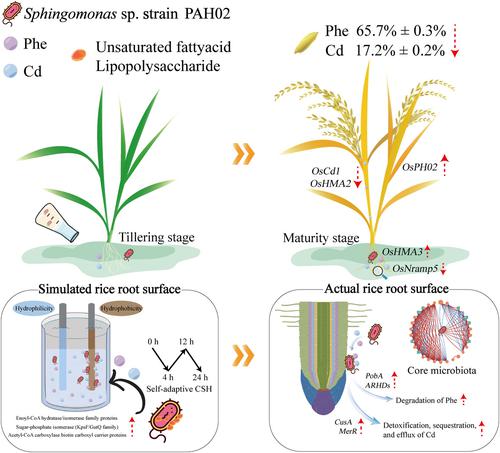当前位置:
X-MOL 学术
›
Environ. Microbiol.
›
论文详情
Our official English website, www.x-mol.net, welcomes your feedback! (Note: you will need to create a separate account there.)
Metagenomic and proteomic insights into the self-adaptive cell surface hydrophobicity of Sphingomonas sp. strain PAH02 reducing the migration of cadmium-phenanthrene co-pollutant in rice
Environmental Microbiology ( IF 5.1 ) Pub Date : 2024-01-06 , DOI: 10.1111/1462-2920.16577 Shengwei Yi 1, 2, 3 , Zhongnan Zhu 1, 2, 3 , Feng Li 1, 2, 3 , Lizhong Zhu 4 , Chen Wu 1, 2, 3 , Fei Ge 1, 2, 3 , Xionghui Ji 5 , Jiang Tian 1, 2, 3
Environmental Microbiology ( IF 5.1 ) Pub Date : 2024-01-06 , DOI: 10.1111/1462-2920.16577 Shengwei Yi 1, 2, 3 , Zhongnan Zhu 1, 2, 3 , Feng Li 1, 2, 3 , Lizhong Zhu 4 , Chen Wu 1, 2, 3 , Fei Ge 1, 2, 3 , Xionghui Ji 5 , Jiang Tian 1, 2, 3
Affiliation

|
Cell surface hydrophobicity (CSH) dominates the interactions between rhizobacteria and pollutants at the soil-water interface, which is critical for understanding the dissipation of pollutants in the rhizosphere microzone of rice. Herein, we explored the effects of self-adaptive CSH of Sphingomonas sp. strain PAH02 on the translocation and biotransformation behaviour of cadmium-phenanthrene (Cd-Phe) co-pollutant in rice and rhizosphere microbiome. We evidenced that strain PAH02 reduced the adsorption of Cd-Phe co-pollutant on the rice root surface while enhancing the degradation of Phe and adsorption of Cd via its self-adaptive CSH in the hydroponic experiment. The significant upregulation of key protein expression levels such as MerR, ARHDs and enoyl-CoA hydratase/isomerase, ensures self-adaptive CSH to cope with the stress of Cd-Phe co-pollutant. Consistently, the bioaugmentation of strain PAH02 promoted the formation of core microbiota in the rhizosphere soil of rice (Oryza sativa L.), such as Bradyrhizobium and Streptomyces and induced gene enrichment of CusA and PobA that are strongly associated with pollutant transformation. Consequently, the contents of Cd and Phe in rice grains at maturity decreased by 17.2% ± 0.2% and 65.7% ± 0.3%, respectively, after the bioaugmentation of strain PAH02. These findings present new opportunities for the implementation of rhizosphere bioremediation strategies of co-contaminants in paddy fields.
中文翻译:

对鞘氨醇单胞菌自适应细胞表面疏水性的宏基因组和蛋白质组学见解。菌株PAH02减少水稻中镉-菲共污染物的迁移
细胞表面疏水性(CSH)主导根际细菌与土壤-水界面污染物之间的相互作用,这对于了解水稻根际微区污染物的消散至关重要。在此,我们探讨了鞘氨醇单胞菌自适应CSH的影响。菌株PAH02对镉-菲(Cd-Phe)共污染物在水稻和根际微生物组中易位和生物转化行为的影响。我们在水培实验中证明菌株PAH02通过其自适应CSH减少了水稻根部表面对Cd-Phe共污染物的吸附,同时增强了Phe的降解和Cd的吸附。MerR、ARHDs 和烯酰辅酶 A 水合酶/异构酶等关键蛋白表达水平的显着上调,确保CSH能够自适应应对 Cd-Phe 共污染物的应激。一致地,菌株 PAH02 的生物强化促进了水稻 ( Oryza sativa L.)根际土壤中核心微生物群的形成,例如慢生根瘤菌和链霉菌,并诱导与污染物转化密切相关的CusA和PobA基因富集。因此,菌株PAH02生物增强后,成熟稻米中Cd和Phe的含量分别降低了17.2%±0.2%和65.7%±0.3%。这些发现为实施稻田共污染物根际生物修复策略提供了新的机遇。
更新日期:2024-01-06
中文翻译:

对鞘氨醇单胞菌自适应细胞表面疏水性的宏基因组和蛋白质组学见解。菌株PAH02减少水稻中镉-菲共污染物的迁移
细胞表面疏水性(CSH)主导根际细菌与土壤-水界面污染物之间的相互作用,这对于了解水稻根际微区污染物的消散至关重要。在此,我们探讨了鞘氨醇单胞菌自适应CSH的影响。菌株PAH02对镉-菲(Cd-Phe)共污染物在水稻和根际微生物组中易位和生物转化行为的影响。我们在水培实验中证明菌株PAH02通过其自适应CSH减少了水稻根部表面对Cd-Phe共污染物的吸附,同时增强了Phe的降解和Cd的吸附。MerR、ARHDs 和烯酰辅酶 A 水合酶/异构酶等关键蛋白表达水平的显着上调,确保CSH能够自适应应对 Cd-Phe 共污染物的应激。一致地,菌株 PAH02 的生物强化促进了水稻 ( Oryza sativa L.)根际土壤中核心微生物群的形成,例如慢生根瘤菌和链霉菌,并诱导与污染物转化密切相关的CusA和PobA基因富集。因此,菌株PAH02生物增强后,成熟稻米中Cd和Phe的含量分别降低了17.2%±0.2%和65.7%±0.3%。这些发现为实施稻田共污染物根际生物修复策略提供了新的机遇。



























 京公网安备 11010802027423号
京公网安备 11010802027423号